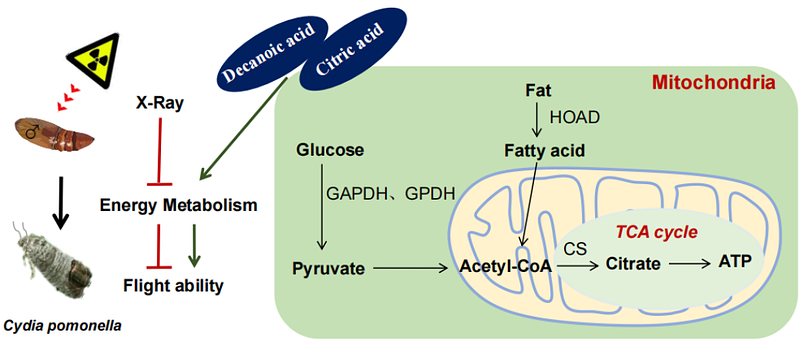X-ray irradiation hinders flight ability of Cydia pomonella male moths by energy metabolism dysfunction

X-ray irradiation hinders flight ability of Cydia pomonella male moths by energy metabolism dysfunction
Zhang, X.-Y.; Wei, Z.-H.; Gao, P.; Li, Y.-T.; Ji, Q.-E.; Yang, X.-Q.
AbstractFlight in insects is essential for behaviors such as courtship, foraging, and migration, with energy metabolism serving as its primary energy source. Previous study indicates that X-ray irradiation, even at optimized doses, compromises the flight capacity of male Cydia pomonella moths utilized in sterile insect technique (SIT) programs. However, the underlying mechanisms of this phenomenon have not been fully understood. In this study, we report that the disruption of energy metabolism processes contributing to the diminished flight capabilities observed in X-ray irradiated sterile C. pomonella moths. Compared to the non-irradiated group, irradiated moths exhibited significantly decreased adenosine triphosphate (ATP) levels. Furthermore, a reduction in the enzymatic activity of key components within carbon metabolism pathways was observed, including citrate synthase (CS) in the tricarboxylic acid cycle (TCA), and glyceraldehyde 3-phosphate dehydrogenase (GAPDH), glycerol 3-phosphate dehydrogenase (GPDH) in glycolysis, and 3-Hydroxyl-CoA dehydrogenase (HOAD) in fatty acid metabolism. Transcriptional analysis revealed downregulation of expression of genes associated with energy metabolism in the primary locomotor tissues post-irradiation, specifically those encoding CS (CS2), GAPDH (Gapdh2), GPDH (GPD2), and HOAD (HADHA, HADH1, B0272, HADH2) enzymes. Additionally, exogenous supplementation with decanoic acid and citric acid, the agonist and product of CS respectively, enhanced the TCA cycle, increased energy production, and restored flight capacity in sterile moths. These findings not only confirm that X-ray irradiation disrupts energy metabolism leading to impaired flight, but also offer a potential strategy to overcome this limitation before releasing sterile moths as component of integrated pest management programme using the SIT.